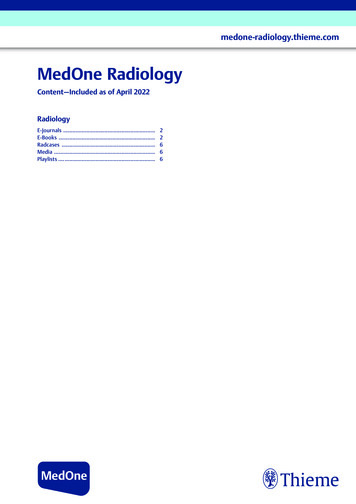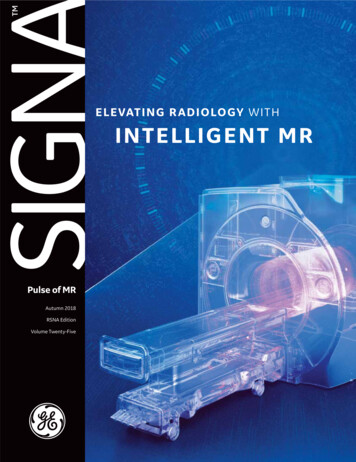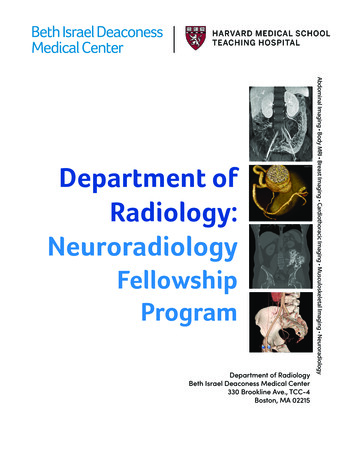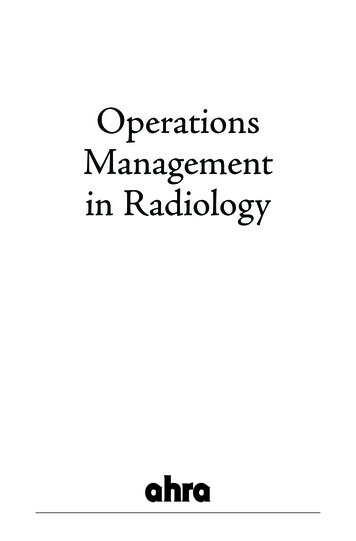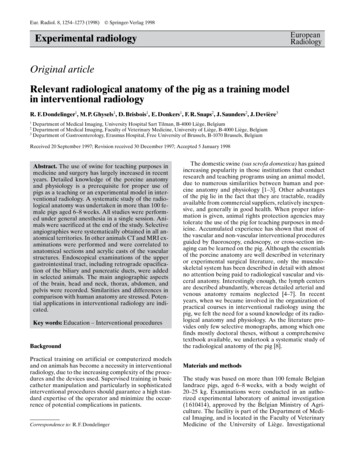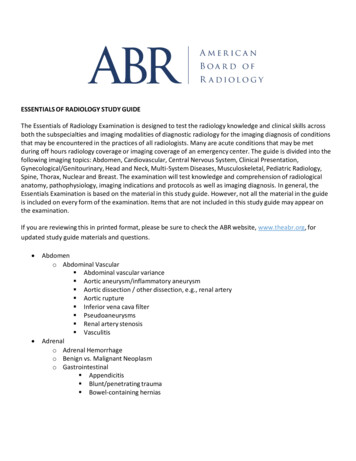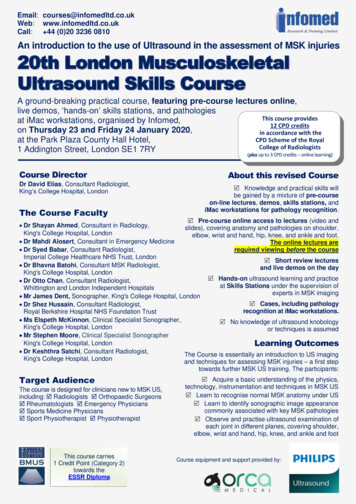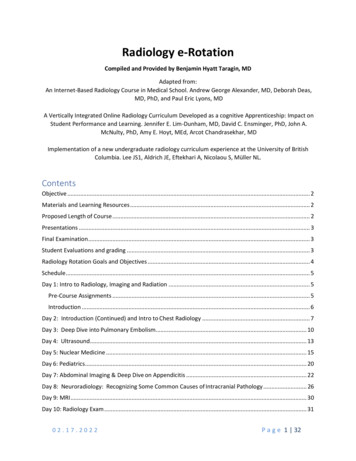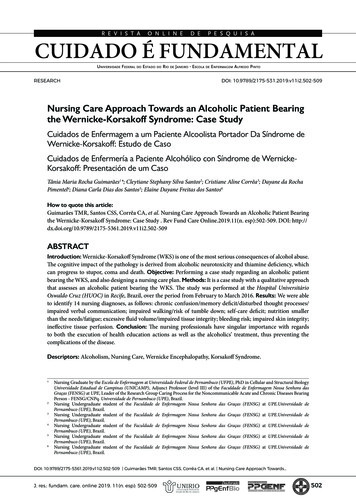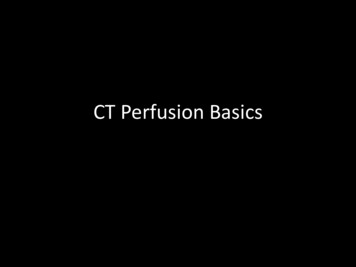
Transcription
CT Perfusion Basics
Basic terms to know in stroke Core– Infarcted brain, not salvageable– Depicted by reduction of cerebral blood flow (CBF) less than 30% ofnormal (CBF 30% volume in mL)– Essentially equivalent to area of diffusion restriction seen on MRIPenumbra– Hypoperfused brain at risk for progression to infarction, salvageable– Usually located around the ischemic core, and represents target ofreperfusion therapy– Is represented by total area of hypoperfused brain MINUS infarcted core– Depicted by prolonged time it takes for contrast to reach and traverseareas of the brain. Most commonly used threshold in CTP is Tmax 6s.
Basic terms to know in stroke Time to Peak (TTP)– Length of time in seconds to reach peak voxel enhancement– Indicator of delayed flow in the setting of stenosis orocclusion– Increased when abnormal Mean Transit Time (MTT)– Length of time in seconds for blood to move from arteries - capillaries - veins– Increase indicates vasodilatory response to reduced flow– MTT CBV/CBF Time to maximum (Tmax)– Time at which maximum value of residue function occursafter deconvolution– Represents delayed arrival of contrast bolusTmax and CBF are the main parameters used to determine core and penumbra
Basic terms to know in stroke Cerebral blood volume (CBV)– Volume flow rate through cerebral vasculature perunit time (ml/100g of brain tissue)– Penumbra may demonstrate normal or increasedCBV with autoregulation Cerebral blood flow (CBF)– Amount of blood flowing through capillaries per unittime per unit tissue (ml/min/100g brain tissue)– Identifies areas of low blood flow (hypoperfusion)– Infarct core displays decreased CBF by 30% Mismatch Volume and Mismatch Ratio– Mismatch volume Difference in volume between totalhypoperfused area and core infarct, equals penumbra– Mismatch ratio Ratio of total hypoperfused area andcore infarctTmax and CBF are the main parameters used to determine core and penumbra
What it looks like (RAPID software, update with Viz AI when have examples) Color maps corresponding to the 2 slabs obtained (below)Need to use the TOTAL values provided which sums the two slabs forbetter coverageColor maps also provided (right, different example), can help withassessing global picture
Questions to answer by CT Hemorrhagic versus ischemic stroke?– Noncontrast head CT Evidence of large vessel occlusion?– CT angiography What tissue is infarcted (core) and what issalvageable (penumbra)?– CT perfusion
Performance of CT Perfusion Monitor first pass of contrast bolus through cerebralcirculation– Usually performed at 2 separate slabs to maximize coveragewith first slab parallel to and just above the orbital roof, and thesecond more superiorly to avoid any overlap in slabs– Power injection at between 4-7 mL/sec CT angiography is then performed with additional bolus ofcontrast CT perfusion software analyzes data and generates colormaps and outputs values– Usually a threshold HU below which the software does notinclude as an area of hypoperfusion to avoid counting priorinfarcts/encephalomalacia in calculations
Sample dictation template
Target values for reperfusion May be in constant evolution and not strictlydefined– Ischemic core volume 60-70 mL May vary depending on location of infarct and patientage with desired aggressiveness– Mismatch ratio 1.8– Mismatch volume 15 mL
Pitfalls Underprediction of final infarction by coreExamples where 27-hour infarct volume is larger than predicted infarctvolume.(A)The baseline core is 14ml (pink); following complete reperfusion, the27-hour infarct volume is 45ml (green outline) and demonstrateshemorrhagic transformation.(B)The baseline core is 10ml (pink); following complete reperfusion, the27-hour infarct volume (green outline) is 47ml and has hemorrhagictransformation.(C) Example of the malignant profile. The baseline core is 24ml (pink) andthe Tmax 10-second volume (shown in red) is 177ml. Following 98%reperfusion, the 27- hour infarct volume (green outline) is 269ml. ICischemic core; IV infarct volumeAlbers, Gregory W., et al. "Ischemic core and hypoperfusion volumes predictinfarct size in SWIFT PRIME." Annals of neurology 79.1 (2016): 76-89.
Pitfalls Core infarct may not show up if there is later recruitment ofcollateral vessels from ACA and PCA (“futile leptomeningealperfusion”) If imaging patients very early (within an hour) after stroke, thevolume of core infarct may be substantially overcalled at aCBF 30% threshold. Within an hour of stroke, a CBF 20%threshold may be more appropriate (not used in currentpractice) Understand that areas of brain with HU under a certainthreshold (approaching CSF density) will not be counted ascore infarct, assumed to represent encephalomalacia Software may only include lesions greater than 3 mL onmismatch maps so lacunar infarcts may not show up. Theymay be visible on the global color maps if provided.
Pitfalls AIF (arterial input function) and VOF (venous output function)– AIF often placed on A2 segment of anterior cerebral artery due to its courseand easy visualization on multiple axial images. The MCA is often used as well.– VOF often placed on superior sagittal sinus– Inappropriate placement of either can give appearance of global perfusionabnormality or other abnormality– If images or numbers don’t look right, verify placement of AIF and VOF andlook at time curves Make sure there is good bolus and curves have sharp upstrokeIf there are a lot of jagged lines in the curves, it is suggestive of movement– Make sure that there is no truncation of the curves (stopped scanning tooearly)Good AIF and VOFplacement and curves
Case 1 CT perfusion shows area ofhypoperfusion in right MCAterritory with total volume of 123ml, core of 20 mL, and penumbra of103 mLPatient underwent successful RICAangioplasty and R MCAthrombectomyFollowup DWI MRI closely matchesinitial area of core infarct seen onCT perfusion, with sparing of someof penumbra area
Case 2 CT perfusion shows area ofhypoperfusion in right MCAterritory with total volume of 190mL, core volume of 74 mL, andpenumbra of 116 mLPatient underwent successful RICAand R MCA thrombectomyFollowup DWI MRI closely matchesinitial area of core infarct seen onCT perfusion, with sparing of muchof penumbra area
Case 3 CT perfusion shows area ofhypoperfusion in left MCA territorywith total volume of 85 mL, coreinfarct of 15 mL, and penumbra of70 mLAttempted left MCA thrombectomywas unsuccessfulFollowup DWI MRI shows infarctclosely resembles initial CTperfusion area of penumbra whichhas progressed to infarct
Summary Total hypoperfused brain volume– Volume of brain with Tmax 6 sec– Equivalent to infarct core PLUS surrounding penumbra Infarct core volume– Volume of brain demonstrating CBF 30%– Non-viable/non-salveagable brain Penumbra volume– Total hypoperfusion volume MINUS core volume– Equals mismatch volume– Potentially salveagable brain
CT perfusion software analyzes data and generates color maps and outputs values –Usually a threshold HU below which the software does not include as an area of hypoperfusion to avoid counting prior infarcts/enc
